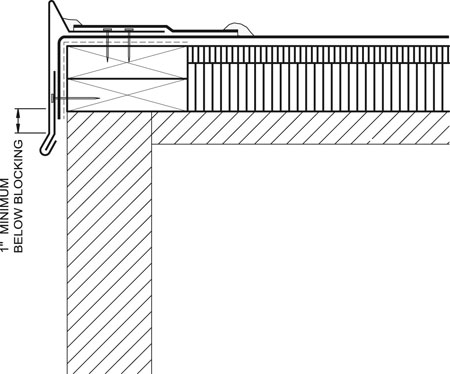The Construction Details sections of The NRCA Roofing Manual: Membrane Roof Systems—2007 and The NRCA Spray Polyurethane Foam-based Roofing Manual—2006 recommend edge metal—such as parapet caps (copings), fascias and gravel stops—overlap the joint at the top of a wall and wood nailer a minimum of 1 inch. Since the early 1970s, NRCA has recommended edge metal overlapping wood nailers and tops of walls. In 1995, NRCA began recommending a 1-inch minimum overlap. Additionally, NRCA does not recommend using sealant between edge metal's drip edge and a wall.
The 1-inch minimum overlap recommendation is based on how far water will move upward under pressure. One equation and one mathematical relationship can explain this relationship.
The equation P = 0.00256 x V2 depicts the relationship between pressure (P); fluid pressure (in this case, the constant 0.00256 is used for the fluid pressure of air); and velocity (V) of that fluid pressure (wind speed).
The mathematical relationship is 1 pound per square foot (lb/ft2) = 0.1922 inches of water. This mathematical relationship is based on pressure differential and the weight of water. Essentially, this relationship means 1 lb/ft2 of pressure will move water upward 0.1922 inches.
Based on this relationship, it theoretically takes 5.2 lb/ft2 of pressure to raise water 1 inch. And based on the equation, the wind speed needed to create a pressure of 5.2 lb/ft2 is 45 mph.
Because a 45-mph wind equates to 5.2 lb/ft2 of pressure and it takes 5.2 lb/ft2 of pressure to raise water 1 inch, a 45-mph wind will raise water 1 inch.
It must be noted a 45-mph wind will raise water 1 inch in conditions with little or no friction. However, in construction there are no such ideal situations. In construction, there is surface tension, and each surface has imperfections. Because of the close proximity of edge metal to a wall, there is surface tension between water and the construction materials, such as galvanized metal, bare aluminum, painted aluminum, masonry, stucco, exterior insulation and finishing systems, wood, or any other metal type or wall material that may be used. And most wall surfaces are irregular and have imperfections that create friction, or drag, preventing water from moving upward freely.
Additionally, the shape of a drip edge may create a wind baffle of sorts that reduces wind speed and, subsequently, the pressure behind the edge metal.
The less-than-ideal parameters on a roof system and potential for wind baffle effects will require a wind speed greater than 45 mph to move water upward 1 inch.

Detail EPDM 3S from The NRCA Roofing Manual: Membrane Roof Systems—2007
NRCA recommends a minimum overlap. Therefore, increasing that overlap means a higher wind speed is needed to move water upward more than 1 inch. For example, it would take a 64-mph wind to raise water 2 inches and a 78-mph wind to raise water 3 inches. Note these examples are based on ideal situations without friction, so wind speeds much greater than 64 mph and 78 mph are needed to raise water 2 or 3 inches, respectively. The surface friction from imperfections perhaps is the largest resistance to upward movement of water. Therefore, overlaps greater than 2 or 3 inches likely are not necessary even in high-wind zones.
Designers of edge metal should realize the pressures used to determine overlap of edge metal should be more equivalent to window design pressures, not the uplift pressures that are used to design roof systems.
Additionally, NRCA's construction details for edge-metal conditions do not include using sealant at the interface of a drip edge and wall to prevent moisture infiltration. It is NRCA's position that including sealant between edge metal's drip edge and a wall generally will prevent the passage of air and water vapor. The addition of sealant likely will trap moisture in the wall construction and prevent the wall from drying out.
To ensure proper design, it is important you understand the reasons behind NRCA's recommendations.
James R. Kirby, AIA, is NRCA's associate executive director of technical communications.
COMMENTS
Be the first to comment. Please log in to leave a comment.